History
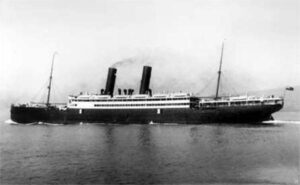 The SS California, owned by Anchor Line Steamship Company; a Scottish merchant shipping company that was founded in 1855 and dissolved in 1980; departed New York on January 29, 1917, bound for Glasgow, Scotland, with 205 passengers and crewmembers on board. While the trip should have been a pleasant journey, world events would soon happen that would change everything in an instant. On February 3, 1917, United States President Woodrow Wilson gave a speech in which he “broke diplomatic relations with Germany and warned that war would follow if American interests at sea were again assaulted.” Of course, all ship sailing the seas, especially those departing or arriving in the United States, or any that had US passengers were warned about the possibility of a German attack.
The SS California, owned by Anchor Line Steamship Company; a Scottish merchant shipping company that was founded in 1855 and dissolved in 1980; departed New York on January 29, 1917, bound for Glasgow, Scotland, with 205 passengers and crewmembers on board. While the trip should have been a pleasant journey, world events would soon happen that would change everything in an instant. On February 3, 1917, United States President Woodrow Wilson gave a speech in which he “broke diplomatic relations with Germany and warned that war would follow if American interests at sea were again assaulted.” Of course, all ship sailing the seas, especially those departing or arriving in the United States, or any that had US passengers were warned about the possibility of a German attack.
February 7, 1917, found the SS California some 38 miles off the coast of Fastnet, Ireland, when the ship’s captain, John Henderson, spotted a submarine off his ship’s port side at a little after 9am. I can only imagine the sinking feeling the captain must have felt at that moment. The Germans were not known for any kind of compassion, and they didn’t particularly care if this was a passenger ship. They figured that the ship might be carrying weapons, and they actually might have been. Captain Henderson ordered the gunner at the stern of the ship to fire in defense, if necessary. Unfortunately, there would not be time to do so, because moments later and without warning, the submarine fired two torpedoes at the ship. The first torpedo missed, but the second torpedo exploded into the port side of the steamer, killing five people instantly. The explosion of that torpedo was so violent and devastating that it caused the 470-foot, 9,000-ton steamer to sink just nine minutes later. The crew quickly sent desperate S.O.S. calls, but the best they could hope for was a hasty arrival of rescue ships. Time was simply not on their side, as 38 people drowned after the initial explosion, and with the initial 5 who died when the torpedo impacted the ship, a total of 43 died. It was an act of war by the Germans.
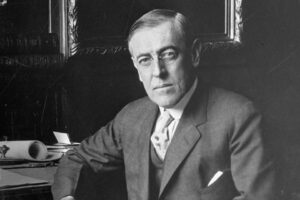 The Germans were known for this type of blatant attack, in complete defiance of Wilson’s warnings. It’s almost as if they were simply crazed with hatred. Because of Wilson’s warnings about the consequences of unrestricted submarine warfare and the subsequent discovery and release of the Zimmermann telegram, the Germans reached out to the foreign minister to the Mexican government involving a possible Mexican-German alliance in the event of a war between Germany and the United States. That caused Wilson and the United States to take the final steps towards war. On April 2, 1917, Wilson delivered his war message before Congress. It was this action that brought about the United States’ entrance into the First World War, which came about just four days later.
The Germans were known for this type of blatant attack, in complete defiance of Wilson’s warnings. It’s almost as if they were simply crazed with hatred. Because of Wilson’s warnings about the consequences of unrestricted submarine warfare and the subsequent discovery and release of the Zimmermann telegram, the Germans reached out to the foreign minister to the Mexican government involving a possible Mexican-German alliance in the event of a war between Germany and the United States. That caused Wilson and the United States to take the final steps towards war. On April 2, 1917, Wilson delivered his war message before Congress. It was this action that brought about the United States’ entrance into the First World War, which came about just four days later.

 My niece, Jenny Masterson is a woman of many talents. As many people know, she is a natural-born hostess. She loves to entertain. That is a rare talent. Most of us get stressed out when we have to host holidays, birthdays, or parties. It’s not that we don’t enjoy having the party, but rather that some of us are great at it and others of us simply throw it together. In reality, many of us would much rather have Jenny plan and execute the party and let us take the credit for it. Jenny is a natural, and her parties are fun. Jenny’s favorite parties are the holidays with family. That stands to reason, because Jenny is all about family. She loves them all.
My niece, Jenny Masterson is a woman of many talents. As many people know, she is a natural-born hostess. She loves to entertain. That is a rare talent. Most of us get stressed out when we have to host holidays, birthdays, or parties. It’s not that we don’t enjoy having the party, but rather that some of us are great at it and others of us simply throw it together. In reality, many of us would much rather have Jenny plan and execute the party and let us take the credit for it. Jenny is a natural, and her parties are fun. Jenny’s favorite parties are the holidays with family. That stands to reason, because Jenny is all about family. She loves them all.

 Jenny also loves to hike the mountains, and since my niece, her cousin Andrea Beach moved back to Casper from Rawlins, she and Jenny have been doing a lot of hiking, even in the winter. Of course, you can’t hike some of the tougher trails in the winter, but they do what they can, in anticipation of the summer hiking season to come. The truth is that these two girls have really become close. They do a lot of things together, and they spend time talking, and just enjoying each other’s company. It’s been a really good thing for both of them. They are both social people, and it’s always nice to have a “bestie” to share things with. They have both been a blessing to each other. Jenny also loves taking her other hiking buddy along too. Bella the dog is always ready to go with the girls and the famiy on the next hiking adventure.
Jenny also loves to hike the mountains, and since my niece, her cousin Andrea Beach moved back to Casper from Rawlins, she and Jenny have been doing a lot of hiking, even in the winter. Of course, you can’t hike some of the tougher trails in the winter, but they do what they can, in anticipation of the summer hiking season to come. The truth is that these two girls have really become close. They do a lot of things together, and they spend time talking, and just enjoying each other’s company. It’s been a really good thing for both of them. They are both social people, and it’s always nice to have a “bestie” to share things with. They have both been a blessing to each other. Jenny also loves taking her other hiking buddy along too. Bella the dog is always ready to go with the girls and the famiy on the next hiking adventure.
Of course, Jenny’s main “bestie” is her husband, Steve Spethman. They have been madly in love since the day they met some 22+ years ago. They are perfect for each other. They have like values and like interests. They 
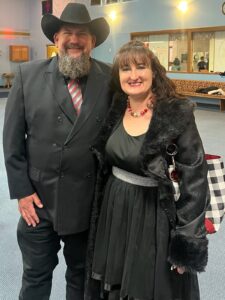 love to travel and see new things. They love their family and watching their children grow up. They love God, and they love growing in faith every day. They stand by each other in good times and in bad times. Each of them knows that the other is there for them and will support them no matter what. They are totally committed to each other, totally happy, and they are best friends. Life just doesn’t get better than that, does it? Today is Jenny’s birthday. Happy birthday Jenny!! Have a great day!! We love you!!
love to travel and see new things. They love their family and watching their children grow up. They love God, and they love growing in faith every day. They stand by each other in good times and in bad times. Each of them knows that the other is there for them and will support them no matter what. They are totally committed to each other, totally happy, and they are best friends. Life just doesn’t get better than that, does it? Today is Jenny’s birthday. Happy birthday Jenny!! Have a great day!! We love you!!
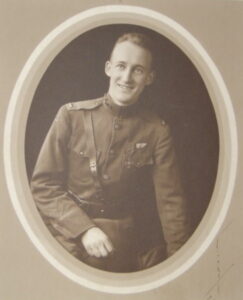 In World War I, airplanes were a relatively new item. The Wright brothers made their first sustained flight on December 17, 1903, so by 1918, they were still barely more than a novelty, but that didn’t matter. The world needed these machines, if the Allied countries were to win World War I. I’m sure that no one really knew how these new machines were going to work out, and I can only imagine how the pilots that had to fly those first planes felt about not only flying in them, but doing combat in them. One of those first crew members was Stephen W Thompson, a 24-year-old gunner on a French aircraft in February 1918.
In World War I, airplanes were a relatively new item. The Wright brothers made their first sustained flight on December 17, 1903, so by 1918, they were still barely more than a novelty, but that didn’t matter. The world needed these machines, if the Allied countries were to win World War I. I’m sure that no one really knew how these new machines were going to work out, and I can only imagine how the pilots that had to fly those first planes felt about not only flying in them, but doing combat in them. One of those first crew members was Stephen W Thompson, a 24-year-old gunner on a French aircraft in February 1918.
Thompson was born on March 20, 1894, in West Plains, Missouri. When the United States entered World War I in April 1917, Thompson was a senior in electrical engineering at the University of Missouri. Men were needed to go and fight, so the school announced that seniors who joined the military before graduation would receive their diplomas in June. Being a loyal American, Thompson enlisted in the Army. He was sent for basic training at Fort Riley, Kansas, and by June he was sent to Fort Monroe, Virginia for training in the Coast Artillery Corps. The train ride to his post would change his life forever, when he spotted an airplane in the sky. It was the first one he had ever seen, and when he got the opportunity, he went to the flying field, the Curtis School at Newport News, and asked if he could take a ride. He figured it might be the only chance he would get, and he didn’t want to miss out. Thomas Scott Baldwin, who had been a famous performer in his own balloons and dirigibles, was in charge and he agreed to give Thompson a ride. The plane 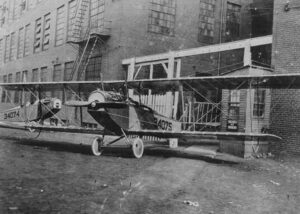 was a Curtiss JN-4 Jenny and the pilot was Edward Stinson, a prominent flyer at the time who later founded the Stinson Aircraft Company.
was a Curtiss JN-4 Jenny and the pilot was Edward Stinson, a prominent flyer at the time who later founded the Stinson Aircraft Company.
After his ride, in which Stinson did a number of aerobatic maneuvers, including looping the loop five times in a row, Thompson said that the only thing that kept him from falling out of the plane at the top of the last loop was the lap belt. I can only imagine how he felt, but that flight changed Thompson’s whole life. He decided to apply for duty in the Air Service. He was accepted, and on February 5, 1918, flying as a gunner on a French aircraft in February 1918, he became the first member of the United States military to shoot down an enemy aircraft. He was not the first person to shoot down another aircraft, because Kiffin Rockwell achieved an earlier aerial victory as an American volunteer member of the French Lafayette Escadrille in 1916. Nevertheless, Thompson was the first “official soldier” to do so. That day, the 1st Aero Squadron had not yet begun combat operations, and Thompson visited a French unit with a fellow member of the 1st Aero Squadron. The men were invited to fly as gunner-bombardiers with the French on a bombing raid over Saarbrücken, Germany. Well, nobody had to ask them twice. The run was successful, but after they had dropped their bombs, the squadron was attacked by Albatros D III fighters. Immediately taking action, Thompson shot down one of them, thereby  carrying out the first aerial victory by any member of the US military. He was awarded the Croix de Guerre with Palm for the action.
carrying out the first aerial victory by any member of the US military. He was awarded the Croix de Guerre with Palm for the action.
After the war Thompson worked at McCook Field for several years as an engineer. Today, McCook Field is Wright-Patterson Air Force Base. Following his time at McCook Field, he became a high school mathematics teacher. During World War II, he taught preflight and meteorology. He maintained an interest in aviation and in 1940 he received US Patent Number 2,210,642 for a tailless flying wing. He died on October 9, 1977, in Dayton, Ohio at age 83.
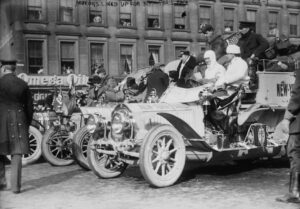
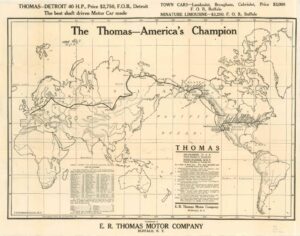 A car race is most often run on a track, with lots of fans cheering everyone on, but in 1908, there was a very strange car race that actually used a track that took the drivers around the world!! How…you might ask?? Well, the car race started in New York City. From there the route took the racers to San Francisco. Normally, San Francisco would be the end of the trail…or the route. You would have reached the Pacific Ocean, and as we all know, cars can’t drive on the ocean…especially cars manufactured in 1908. So, the racers turned to the north and headed for Valdez, Alaska. They would arrive in Valdez in the height of winter…at a time when the Bering Strait was frozen over…theoretically. At that point there was supposed to be an ice bridge across the Bering Strait, making it possible for the cars to drive right over it and into Russia. Once across, the racers would continue on from Russia to Europe and the finish line awaiting them in Paris. It’s amazing to me to think about cars being driven around the world, but of course the Bering Strait in the Winter, supposedly changed everything. In 1908, cars were relatively new, so road infrastructure was limited to only metropolitan areas, and even then, a lot of it was cobbled stone. So, I suppose cross country car travel on dirt trails was not that uncommon.
A car race is most often run on a track, with lots of fans cheering everyone on, but in 1908, there was a very strange car race that actually used a track that took the drivers around the world!! How…you might ask?? Well, the car race started in New York City. From there the route took the racers to San Francisco. Normally, San Francisco would be the end of the trail…or the route. You would have reached the Pacific Ocean, and as we all know, cars can’t drive on the ocean…especially cars manufactured in 1908. So, the racers turned to the north and headed for Valdez, Alaska. They would arrive in Valdez in the height of winter…at a time when the Bering Strait was frozen over…theoretically. At that point there was supposed to be an ice bridge across the Bering Strait, making it possible for the cars to drive right over it and into Russia. Once across, the racers would continue on from Russia to Europe and the finish line awaiting them in Paris. It’s amazing to me to think about cars being driven around the world, but of course the Bering Strait in the Winter, supposedly changed everything. In 1908, cars were relatively new, so road infrastructure was limited to only metropolitan areas, and even then, a lot of it was cobbled stone. So, I suppose cross country car travel on dirt trails was not that uncommon.
The Great Race of 1908 began on February 3rd of that year and immediately ran into challenges. Just to list a few…cars breaking down multiple times, lack of usable roads, car-hating people giving wrong directions, and, oh yeah, SNOW!!! Nevertheless, the teams persevered, and the first team reached San Francisco in 41 days. The came the obstacle of the fact that the proposed route from San Francisco to Alaska did not exist. I guess that they didn’t think it would be feasible to create the route, so the race organizers allowed teams to ship their cars to Valdez, Alaska, then continue on the Ice Bridge. Some might have called that a bit of a cheat, but I guess if all the racers id it, it wasn’t really cheating. Once in Valdez, the teams found out that there is, in fact, no ice bridge across the Bering Strait anymore, because it melted about 20,000 YEARS AGO. Oops…small oversight. So, the racers were allowed to ship their cars across the Pacific to Japan, then Russia, to carry on. Ok, if you’re like me, at this point, you are starting to see that this race had a lot of flaws in the planning. And honestly, while I knew there was no ice bridge on the Bering Strait today, I was unaware that it melted that long ago…meaning there was not an ice bridge since the “Ice Age!!”
So, was this really a car race around the world or a whole lot of non-sense. To be sure, the six teams did end up in Paris after the race, and they drove all of the route that could be driven, but the reality is that much of the race was simply cars being transported by ships across the ocean. Nevertheless, the “official” race was documented as just that…a car race that went around the world. The cars had to fight mud, snow, and mechanical problems. It was “officially” won by The Thomas Flyer, built by the Thomas Motor Company, was a 1907 Model 35 with a 4-cylinder, 60-horsepower engine capable of reaching 60 mph. It was fully loaded with two shovels, two picks, two lanterns, eight searchlights, two extra gas tanks (with a capacity of ten gallons), five hundred feet of rope, a rifle and revolvers. It was also equipped with an attachable top…much like those used on covered wagons…that could wrap the entire car and offer an enclosed place to sleep. On July 30, after 169 days of travel, the Thomas car entered Paris. Even in Paris, they almost didn’t finish, because a police 
 officer stopped the vehicle, saying it had no working headlight, and couldn’t proceed. A passing bicyclist witnessed the scene and offered to load his bike into the car. Since the bicycle had a working headlight, the officer allowed them to pass. The Thomas Flyer finally finished at 6:00pm. The race was the only “official” car race around the world.
officer stopped the vehicle, saying it had no working headlight, and couldn’t proceed. A passing bicyclist witnessed the scene and offered to load his bike into the car. Since the bicycle had a working headlight, the officer allowed them to pass. The Thomas Flyer finally finished at 6:00pm. The race was the only “official” car race around the world.

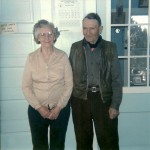 My husband, Bob Schulenberg’ grandmother, Vina Hein was born of Groundhog Day. I don’t know if she thought that was cool or not, but I suspect she did. I think it would a fun birthday to have. Not that I would want it to be mine. Isn’t it funny that our birthday…no matter which day that is for you…always seems like the most special birthday of all. Most of us wouldn’t change that day for any other day. It doesn’t matter if it’s a holiday, the first day of the month, the last day of a month, or any day in between, it’s your own day…and that’s all that matters.
My husband, Bob Schulenberg’ grandmother, Vina Hein was born of Groundhog Day. I don’t know if she thought that was cool or not, but I suspect she did. I think it would a fun birthday to have. Not that I would want it to be mine. Isn’t it funny that our birthday…no matter which day that is for you…always seems like the most special birthday of all. Most of us wouldn’t change that day for any other day. It doesn’t matter if it’s a holiday, the first day of the month, the last day of a month, or any day in between, it’s your own day…and that’s all that matters.
Of course, as for Groundhog Day, for the “Winter Weary” ones of the population, that is an important day. I’m sure that Punxsutawney Phil gets his predictions wrong as often as he gets them right. Nevertheless, countless numbers of people watch the news to find out what he had to say today. This turned out to be a rare year, in which Punxsutawney Phil did not see his shadow, and therefore predicted an early Spring. It’s not really surprising, in that we have also had a mild Winter, but it is not common for Winter to give up so easily…and trust me when I say, that I really hope the prediction is correct. I, for one, and over Winter, with the first snow. I can get all the Winter I need in a picture or a Christmas card. I’m so ready for April showers that bring May flowers. I’m ready for lovely walks along the trails near my house, and the greenness that I hope we get again. Come on Spring!!
I think Grandma Hein would have agreed with me on that one, because Winters on the ranch were not easy. 
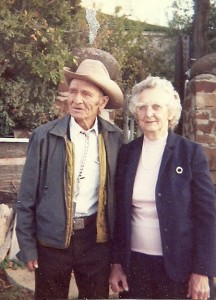 The Montana winters can be really harsh, and when you live on a ranch, you might find yourself snowed in for weeks at a time. I can picture Heaven for Grandma as beautiful spring flowers, and soft breezes, not to cold and not too hot…and not too much work to do. Although, I can’t imagine her just sitting around too much. She did like being busy. I look forward to seeing her again, when I get to Heaven. Today is the 115th anniversary of Grandma Hein’s birth…and Groundhog Day too. Happy birthday in Heaven, Grandma Hein. We love and miss you very much!! And Happy Groundhog Day, everyone.
The Montana winters can be really harsh, and when you live on a ranch, you might find yourself snowed in for weeks at a time. I can picture Heaven for Grandma as beautiful spring flowers, and soft breezes, not to cold and not too hot…and not too much work to do. Although, I can’t imagine her just sitting around too much. She did like being busy. I look forward to seeing her again, when I get to Heaven. Today is the 115th anniversary of Grandma Hein’s birth…and Groundhog Day too. Happy birthday in Heaven, Grandma Hein. We love and miss you very much!! And Happy Groundhog Day, everyone.
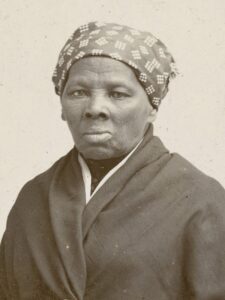
 When we think of things like witness protection or a criminal hiding out, the idea is to find a way to hide in plain sight. A disguise is the first thing that might come to mind, but that is not always the case. When Harriet Tubman, who is best known today as a brave freedom fighter and abolitionist, was in the thick of the movement to free the slaves, she was faced with some particularly dangerous situations. Harriett Tubman was born Araminta “Minty” Ross to enslaved parents, Harriet (“Rit”) Green and Ben Ross in March of 1822. Rit and Ben were enslaved by different families, so it seems unlikely that they would later be able to have a child together, but Mary Pattison Brodess (and later her son Edward), who was Rit’s owner, and Anthony Thompson, who enslaved Ben, would marry, thereby connecting the two families. Thompson ran a large plantation near the Blackwater River in the Madison area of Dorchester County, Maryland. So, Harriett (Minty) was born into slavery. Like most slaves, Tubman was beaten and whipped by enslavers as a child. Those beatings resulted in a traumatic head wound when an irate overseer threw a heavy metal weight, intending to hit another slave, but hit her instead. The injury caused dizziness, pain, and spells of hypersomnia, which occurred throughout her life. The injury resulted in strange visions and vivid dreams, that lasted for the rest of her life. She ascribed to premonitions from God. These experiences, combined with her Methodist upbringing, led her to become devoutly religious.
When we think of things like witness protection or a criminal hiding out, the idea is to find a way to hide in plain sight. A disguise is the first thing that might come to mind, but that is not always the case. When Harriet Tubman, who is best known today as a brave freedom fighter and abolitionist, was in the thick of the movement to free the slaves, she was faced with some particularly dangerous situations. Harriett Tubman was born Araminta “Minty” Ross to enslaved parents, Harriet (“Rit”) Green and Ben Ross in March of 1822. Rit and Ben were enslaved by different families, so it seems unlikely that they would later be able to have a child together, but Mary Pattison Brodess (and later her son Edward), who was Rit’s owner, and Anthony Thompson, who enslaved Ben, would marry, thereby connecting the two families. Thompson ran a large plantation near the Blackwater River in the Madison area of Dorchester County, Maryland. So, Harriett (Minty) was born into slavery. Like most slaves, Tubman was beaten and whipped by enslavers as a child. Those beatings resulted in a traumatic head wound when an irate overseer threw a heavy metal weight, intending to hit another slave, but hit her instead. The injury caused dizziness, pain, and spells of hypersomnia, which occurred throughout her life. The injury resulted in strange visions and vivid dreams, that lasted for the rest of her life. She ascribed to premonitions from God. These experiences, combined with her Methodist upbringing, led her to become devoutly religious.
Tubman became an abolitionist, and started to wage a war on slavery, although she obviously waged war in a very different way than most wars are waged. In 1849, she escaped from her owners and went to Philadelphia, but it was not enough to have her freedom, she wanted her whole family free. So, she returned to Maryland to rescue her family very soon after. It was hard and dangerous work, but she slowly, one group at a time, brought relatives with her out of the state, and eventually guided dozens of other enslaved people to freedom. Tubman, also known as “Moses” traveled by night and in extreme secrecy, but as she later said she “never lost a passenger” on her route. After the Fugitive Slave Act of 1850 was passed, she helped guide escapees farther north into British North America (Canada) and helped newly freed people find work. Tubman met John Brown in 1858 and helped him plan and recruit supporters for his 1859 raid on Harpers Ferry.
Tubman, in order to stay safe, had to hide in plain sight, and as an undercover agent helping escaped enslaved people, she was known to carry chickens with her. You might be wondering why that would be. Tubman had to walk right by slavers, and those sent to recapture escaped slaves, so when she thought a slaver might be getting suspicious of her, she would release the chickens and then recapture them. I’m sure the slavers watched the commotion, but they just thought she was a slave recapturing the chickens for her owners. Little did they know how wrong they were. Simply put, the commotion was so distracting that the slave masters didn’t notice who she was! Sometimes, she would also pretend to read a newspaper, because enslaved people weren’t supposed to be able to read, so she wouldn’t be suspected! While her owners had thought she was just a “dumb slave girl” who didn’t know anything, she was actually a very smart woman, who outsmarted them all.

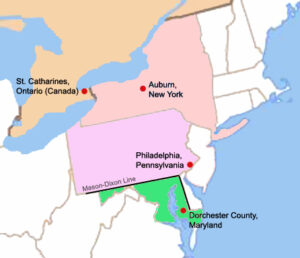
Harriett Tubman is credited with emancipating about 300 slaves…all while hiding in plain sight!! Pretty wise is you ask me. By 1911, Tubman’s body was so frail that she was admitted into the rest home named in her honor. A New York newspaper described her as “ill and penniless,” which prompted supporters to offer a new round of donations. Just before she died, she quoted the Gospel of John to those in the room, “I go away to prepare a place for you.” Tubman was buried with semi-military honors at Fort Hill Cemetery in Auburn, New York.
 My sisters, Cheryl Masterson, Caryl Reed, Alena Stevens, Allyn Hadlock, and I decided a while back to start a Sisters’ Book Club. The idea was to pick a book that we all would read, and then we would discuss the book over dinner. We decided to start our book club with books about the Presidents of the United States, and our first book was, of course, about George Washington. We decided to take turns picking the book, and I found one called “The Spiritual Journey of George Washington” and was so excited that I sort of cut in line, because I am the second sister and should have chosen the second book. Thankfully my sister Cheryl forgave my infraction of the rules among sisters and let me go first. Thanks, Cheryl.
My sisters, Cheryl Masterson, Caryl Reed, Alena Stevens, Allyn Hadlock, and I decided a while back to start a Sisters’ Book Club. The idea was to pick a book that we all would read, and then we would discuss the book over dinner. We decided to start our book club with books about the Presidents of the United States, and our first book was, of course, about George Washington. We decided to take turns picking the book, and I found one called “The Spiritual Journey of George Washington” and was so excited that I sort of cut in line, because I am the second sister and should have chosen the second book. Thankfully my sister Cheryl forgave my infraction of the rules among sisters and let me go first. Thanks, Cheryl.
This book told of so many amazing things that George Washington did. The most important thing was he Devotion to God. George and his wife, Martha set aside time every day to have Bible study and devotion. They did this as a couple…in full agreement. It was such a strong act of faith and loyalty to God. These times with the Lord truly shaped the kind of man and president George Washington. George Washington had no children of his own, but he raised the two children Martha had from her first marriage. Those children grew up to be respectable people who lived proper lives. He never shirked his duties to Martha’s children. He was a good father, and they loved him very much.
As a soldier and later a General, George Washington was totally a totally amazing “miracle man” without a doubt. He never “sent” his men into battle, he “led” his men into battle. He wasn’t sitting on the sidelines where it was “safe” but rather he was in the thick of it…so much so, that after a battle, his clothes and hat often had bullet holes in them, but he was completely unharmed!! George Washington even had two horses shot out from under him, but he was unhurt. In one of the battles he was in, an Indian warrior, who was a leader in the battle, later said, “Washington was never born to be killed by a bullet! I had seventeen fair fires at him with my rifle, and after all could not bring him to the ground!” The he went on to say, “Listen! The Great Spirit  protects that man (indicating Washington) and guides his destinies…he will become the chief of nations, and a people yet unborn will hail him as the founder of a mighty empire. I am come to pay homage to the man who is the particular favorite of Heaven, and who can never die in battle.” Another Native American chief in the same battle, Red Hawk also claimed to have shot at Washington eleven times without hitting him. That must have been a terrible shock in the midst of battle, nevertheless, Red Hawk was convinced that the Great Spirit was protecting him, so he stopped firing. There are many other examples of God’s hand on the life of our beloved first President and military hero. While Washington died young by today’s standards, it did not die in battle. Rather his death was caused by a combination of a severe cold or flu, followed by an ancient practice of “bleeding the patient” and the lack of a suggested tracheotomy that likely would have saved his life. Our first meeting of the Sisters’ Book Club was a huge success, and we are moving on to a book about our second president, John Adams. Stay tuned.
protects that man (indicating Washington) and guides his destinies…he will become the chief of nations, and a people yet unborn will hail him as the founder of a mighty empire. I am come to pay homage to the man who is the particular favorite of Heaven, and who can never die in battle.” Another Native American chief in the same battle, Red Hawk also claimed to have shot at Washington eleven times without hitting him. That must have been a terrible shock in the midst of battle, nevertheless, Red Hawk was convinced that the Great Spirit was protecting him, so he stopped firing. There are many other examples of God’s hand on the life of our beloved first President and military hero. While Washington died young by today’s standards, it did not die in battle. Rather his death was caused by a combination of a severe cold or flu, followed by an ancient practice of “bleeding the patient” and the lack of a suggested tracheotomy that likely would have saved his life. Our first meeting of the Sisters’ Book Club was a huge success, and we are moving on to a book about our second president, John Adams. Stay tuned.

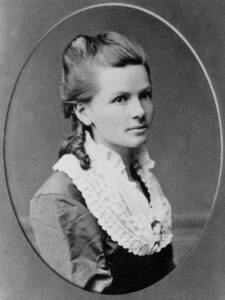 In the United States, at least, many of us equate the first car to Henry Ford, but in reality, that is not the case. In fact, the first car wasn’t built in the United States at all. Henry Ford made great strides in the automobile industry, to be sure, but he didn’t start it all. That honor goes to two European engineers, Karl Benz and Emile Levassor. Benz and Levassor created the first automobile in the 19th Century.
In the United States, at least, many of us equate the first car to Henry Ford, but in reality, that is not the case. In fact, the first car wasn’t built in the United States at all. Henry Ford made great strides in the automobile industry, to be sure, but he didn’t start it all. That honor goes to two European engineers, Karl Benz and Emile Levassor. Benz and Levassor created the first automobile in the 19th Century.
Benz patented the first automobile in 1886. It was called the Benz Patent-Motorwagen (meaning “patent motorcar”), and it was actually built in 1885 by Karl Benz. This one is widely regarded as the world’s first production automobile…meaning a self-propelled vehicle for carrying people. I suppose that at the time, the vehicle was considered expensive with an original cost of 600 imperial German marks, which equates to approximately 150 US dollars, or about $4,321 in 2020. Karl Benz applied on January 29, 1886, and the vehicle was awarded the German patent number 37435. Following official procedures, the date of the application  became the patent date for the invention once the patent was granted, which occurred in November of that year. Benz actually unveiled his invention to the public on July 3, 1886, on the Ringstrasse in Mannheim. About 25 Patent-Motorwagen were built between 1886 and 1893. The car is currently being maintained by Mercedes-Benz Classic.
became the patent date for the invention once the patent was granted, which occurred in November of that year. Benz actually unveiled his invention to the public on July 3, 1886, on the Ringstrasse in Mannheim. About 25 Patent-Motorwagen were built between 1886 and 1893. The car is currently being maintained by Mercedes-Benz Classic.
The “car” was really a glorified tricycle…with a motor, of course. It had three wheels that looked much like bicycle wheels. It would not be the kind of car that a person would want to ride in during the winter months. There is no top on the vehicle at all, and of course, no heat. It’s just you and the elements. Still, you could get where you were going faster, at least for that time in history. So, you didn’t have to be out in the elements as long. The car was a little primitive, but it did set a record or two. On August 5, 1888, Karl Benz wife, Bertha was the first person to drive an internal-combustion-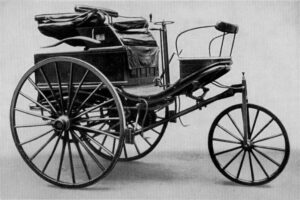
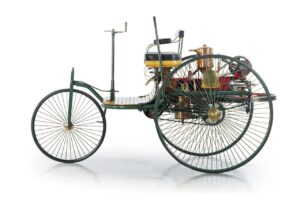 engined automobile over a long distance…about 65 miles. Long for the time, I guess. She was actually field testing the Benz Patent-Motorwagen. They were working on inventing a brake lining and solving several practical issues during the journey. The car did well, and in doing so, she brought the Patent-Motorwagen some worldwide attention and got the company its first sales. It was an amazing day.
engined automobile over a long distance…about 65 miles. Long for the time, I guess. She was actually field testing the Benz Patent-Motorwagen. They were working on inventing a brake lining and solving several practical issues during the journey. The car did well, and in doing so, she brought the Patent-Motorwagen some worldwide attention and got the company its first sales. It was an amazing day.

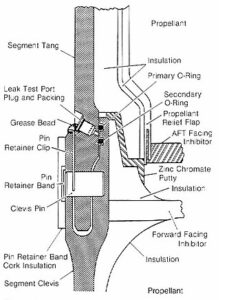 The Space Shuttle Challenger mission, named STS-51-L, was the twenty-fifth Space Shuttle flight and the tenth flight of Challenger. The crew was announced on January 27, 1985, and was commanded by Dick Scobee. Michael Smith was assigned as the pilot, and the mission specialists were Ellison Onizuka, Judith Resnik, and Ronald McNair. The two payload specialists were Gregory Jarvis, who was assigned to conduct research for the Hughes Aircraft Company, and Christa McAuliffe, who flew as part of the Teacher in Space Project. The mission was originally scheduled for July 1985, but was delayed to November and then to January 1986. The mission was scheduled to launch on January 22, but was delayed until January 28, 1986. This was definitely a “less than ideal” situation. Delay after delay, maybe should have raised a serious red flag, but somehow, it did not. At least not to the people who could have changed the outcome.
The Space Shuttle Challenger mission, named STS-51-L, was the twenty-fifth Space Shuttle flight and the tenth flight of Challenger. The crew was announced on January 27, 1985, and was commanded by Dick Scobee. Michael Smith was assigned as the pilot, and the mission specialists were Ellison Onizuka, Judith Resnik, and Ronald McNair. The two payload specialists were Gregory Jarvis, who was assigned to conduct research for the Hughes Aircraft Company, and Christa McAuliffe, who flew as part of the Teacher in Space Project. The mission was originally scheduled for July 1985, but was delayed to November and then to January 1986. The mission was scheduled to launch on January 22, but was delayed until January 28, 1986. This was definitely a “less than ideal” situation. Delay after delay, maybe should have raised a serious red flag, but somehow, it did not. At least not to the people who could have changed the outcome.
One man…Roger Boisjoly knew that the Challenger space shuttle might fail catastrophically at any time. There may have been others I suppose, but none that chose to try to take action. Boisjoly knew that every mission was an accident waiting to happen. Knowing that, he tried to stop the launch on January 28, 1986. He had a definite sick feeling about this mission, but NASA refused to acknowledge his objections. That fact amazes me!! Boisjoly was a rocket engineer who worked for a company that NASA contracted with. He had noticed that the Challenger’s booster rockets had a major design flaw. Their elastic seals had a tendency to stiffen and unseal in cold weather. I’m sure that most of NASA simply took for granted that there would not be much cold weather in Florida. Nevertheless, on this occasion, the Challenger was scheduled for a winter launch. The time had come, and Boisjoly knew that the temperatures would be too low for the booster rocket seals to handle, even in Florida. He convinced colleagues at his engineering company to formally recommend NASA delay the launch. They did, but NASA ignored that recommendation. It was a life altering, or life ending decision on NASA’s part. Most of us know that the rest is history. The launch took place, the seals failed, and the Challenger exploded less than two minutes after it launched. That day, because of the foolish stubbornness and arrogance of NASA, seven people lost their lives. The air temperature on that January 28 was predicted to be a record-low for a Space Shuttle launch. The air temperature was forecast to drop to 18° F overnight before rising to 22° F at 6:00am and 26° F at the scheduled launch time of 9:38am. For most of us, those temperatures wouldn’t seem 
 to be so severe, but for that little seal, it was very severe. Why couldn’t they have swallowed their pride, and postponed a little longer until the temperature warmed a bit. Were we really in that big a rush to start that mission, that we were willing risk the lives of seven people in the attempt. I love the space program and all that it has accomplished, but the people who made that choice that day were foolish and selfish.
to be so severe, but for that little seal, it was very severe. Why couldn’t they have swallowed their pride, and postponed a little longer until the temperature warmed a bit. Were we really in that big a rush to start that mission, that we were willing risk the lives of seven people in the attempt. I love the space program and all that it has accomplished, but the people who made that choice that day were foolish and selfish.
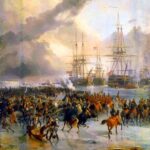
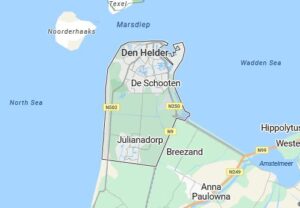 Anytime a country, engaged in a war, can capture a ship belonging to their enemy, they will find themselves strategically in a better position than before, but to capture the entire fleet…now that can mean the difference between winning and losing the war. On January 23, 1795, at Den Helder, North Holland, Netherlands, an extremely rare occurrence took place when a French Revolutionary Hussar cavalry regiment came across a Dutch fleet at anchor in the Nieuwediep, just east of the town of Den Helder. While it was not unusual to come across ships at anchor, what is extremely rare is an interaction between warships and cavalry. One being on land and one on the water, usually prevented any interaction, since the men on horses couldn’t carry guns big enough to reach the ships under normal conditions. The difference in this situation was, of course, that the Dutch fleet was frozen at anchor, not simply sitting at anchor. They had no place they could go. The men on the Dutch fleet knew that they were “sitting ducks” with no recourse, so after some of the Hussars had approached across the frozen Nieuwediep, a negotiation began. It was decided that all 14 Dutch warships would remain at anchor. It was a pretty easy negotiation, because in reality, the Dutch fleet had no other choice. They were now prisoners of war and their capture had happened without violence or even a battle. In an extremely rare even the Dutch fleet was captured by the French Revolutionary Hussars on horseback.
Anytime a country, engaged in a war, can capture a ship belonging to their enemy, they will find themselves strategically in a better position than before, but to capture the entire fleet…now that can mean the difference between winning and losing the war. On January 23, 1795, at Den Helder, North Holland, Netherlands, an extremely rare occurrence took place when a French Revolutionary Hussar cavalry regiment came across a Dutch fleet at anchor in the Nieuwediep, just east of the town of Den Helder. While it was not unusual to come across ships at anchor, what is extremely rare is an interaction between warships and cavalry. One being on land and one on the water, usually prevented any interaction, since the men on horses couldn’t carry guns big enough to reach the ships under normal conditions. The difference in this situation was, of course, that the Dutch fleet was frozen at anchor, not simply sitting at anchor. They had no place they could go. The men on the Dutch fleet knew that they were “sitting ducks” with no recourse, so after some of the Hussars had approached across the frozen Nieuwediep, a negotiation began. It was decided that all 14 Dutch warships would remain at anchor. It was a pretty easy negotiation, because in reality, the Dutch fleet had no other choice. They were now prisoners of war and their capture had happened without violence or even a battle. In an extremely rare even the Dutch fleet was captured by the French Revolutionary Hussars on horseback.
Jean-Charles Pichegru was the leader of the French units…the 8th Hussar Regiment and the Voltigeur company of the 15th Line Infantry Regiment of the French Revolutionary Army, who had been assigned to invade the Dutch Republic. The Dutch fleet was commanded by captain Hermanus Reintjes. This rare event took place during the War of the First Coalition, which was part of the French Revolutionary Wars. The little town of Den Helder is located at the tip of the North Holland peninsula, south of the island of Texel, near the shallow Zuiderzee bay (which means Southern Sea). The Zuiderzee was closed off and partly drained in the 20th century, and what is left of it now forms the freshwater IJsselmeer.
Nevertheless, in the fall of 1794, during the War of the First Coalition of the French Revolutionary Wars, the area was the site of one of the most bizarre captures in history. That day, the Dutch proclaimed the Batavian Republic, effectively ending the war with France and allying itself with France instead. Suddenly, the French were no longer enemies of the Dutch, which seems like a good move in light of the capture. Nevertheless, there were those among the Dutch Navy and the army there who remained loyal to the Stadtholder, and there were fears that Navy ships from Den Helder might sail for England to rejoin William V, Prince of Orange. For that reason, the new Batavian interim Government issued orders to all its fleets at Vlissingen, Hellevoetsluis and at Den Helder, not to fight against the French if they appeared, and to keep the ships at anchor to make sure they could be ready to defend the new Republic against the British.
This event might not have been possible, were it not for the fact that the winter of 1794–1795 was exceptionally cold, causing the Zuiderzee to freeze. Pichegru saw an opportunity and ordered General of Brigade Jan Willem de Winter to lead a squadron of the 8th Hussar Regiment to Den Helder. De Winter had been serving with the French since 1787 and would later command the Dutch fleet in the disastrous Battle of Camperdown. So, while he was successful in one operation, he might not have been the best leader in the long 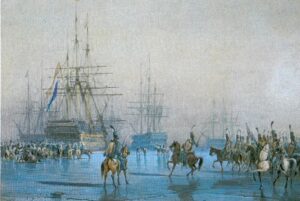
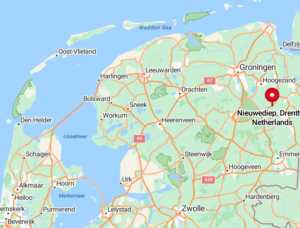 run. Still, the operation was carried out with no casualties. The French simply received the assurance from the Dutch captain that the vessels and their crews would remain at anchor until the political situation in the Dutch Republic would have become clear. The situation was finally settled in May 1795 under the Treaty of The Hague, when the Batavian Republic officially became a French ally. Now, its ships would serve a common cause.
run. Still, the operation was carried out with no casualties. The French simply received the assurance from the Dutch captain that the vessels and their crews would remain at anchor until the political situation in the Dutch Republic would have become clear. The situation was finally settled in May 1795 under the Treaty of The Hague, when the Batavian Republic officially became a French ally. Now, its ships would serve a common cause.

